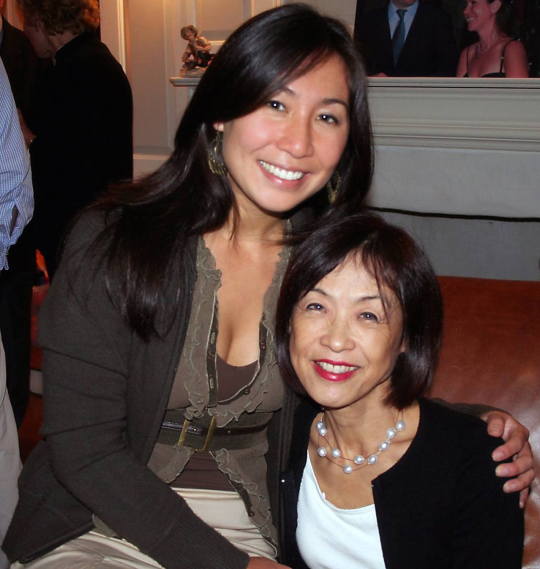By: Vivien Kim Thorp

The author and her mother.
As a teenager, I would stand with my mother in front of her mirrored closet doors and compare our physiques. I would joke that she could, if needed, completely hide behind me … On the other hand, if I stood behind her, there’d be no hiding. Instead, a perfect outline – two to three inches of human flesh sticking out in every side.
I was like a supersized version of my mother – outweighing her by almost 40 pounds, despite being only three inches taller. Her feet were smaller, her hands were smaller, everything about her was just plain smaller. The only thing she had more of than me was hair.
When I was only eight years old, a friend of hers came over and nearly jumped out of her seat when I tried to sit on my mother’s lap. “You’ll crush her,” she exclaimed. People also like to joke, “How could you come out of this tiny little thing?” It didn’t seem so funny to me.
I think my mother had a love-hate relationship with her own body. On the one hand, she knew she looked good. She wore a bikini well into her 40s, inviting whistles from boys who could have been her children on the beach. And with a mannequin-like figure, most everything looked good on her, as long as it came in a small enough size… She was like a clothes hanger. She was like a doll.
On the other hand, she’d always felt self-conscious about how thin she was. “When I was a teenager in Korea,” she said, “Strangers, old women on the bus, would come up to me and say, ‘You’re too skinny. No man is ever going to marry you’. Fatten up!”
It seemed crazy to me that in a world with Kate Moss-like models, that anyone could ever think my mother was too thin. But then they did …
Women at our church, most of them full-figured, soccer-mom types, were indignant about my mother’s size. Muttering about her needing to put on weight. My uncle, a physician, once exclaimed with exasperation – “Just eat something!”
And I got so angry. Because that was the thing … My mother did eat. She ate in abundance. In fact, she ate all the time. A whole apple pie would disappear in two days, with my having had only one slice. A pint of Ben & Jerry’s equaled a single serving. Often, after having eaten in such excess, her stomach would turn on her. And she’d be miserable and in pain with a small but bloated stomach for hours.
Mom would then “make up” for this by eating too much of “good things” – too many radishes, too much steamed broccoli, homemade vegetable juices, liquids with amino acids, pro-biotics and special pollen or seeds.
I suppose now we’d call it “emotional eating” or “self-medication,” but I didn’t have the vocabulary for that then. I had neither the words nor the distance to diagnose my mother’s eating or to understand what voids these foods were meant to fill. But looking back with adult eyes, I see the loneliness, the long mornings spent in bed. I understand the dark isolation that came after my father’s early death, and after that of a boyfriend and of a stepfather after that. But the food never did seem to fill the void. It never took. Instead all those things she hoped would bring her joy or relief just passed through her, leaving only pain and disappointment in their wake.
As my mother got older, she got smaller. And then she got sick. It didn’t matter what hormones did to others. Prednisone plumps the average person up like a prized pig, but not my mother. She just got thinner and thinner. She couldn’t sleep, she couldn’t eat, and she couldn’t breathe.
I was 30 when my mother died. She was 58. Over the phone from New York, suspicious after so many unanswered calls, I talked a friend in through the garage. I heard her call my mother’s name over the phone, and then scream “Oh God.” Then the line cut, and I knew she had died.
It was 24 hours later that I arrived, sleep-deprived and in a stupor, at the home we’d shared for so many years. And I stood in that same room, with mirrored closet doors, and stared at the emptiness around me. On the bed, someone had laid out clothes. A pink sweatshirt with matching pants – both decorated in hearts. They were, I was certain, children’s clothes – far too small for any normal woman to wear.
About the Author: Vivien Kim Thorp is the Executive Communications Manager for the Golden Gate National Parks Conservancy. She is passionate about connecting people with the great outdoors. When not working, she’s usually hiking with her beloved pooch, Badger, or getting dirty in the veggie garden.
